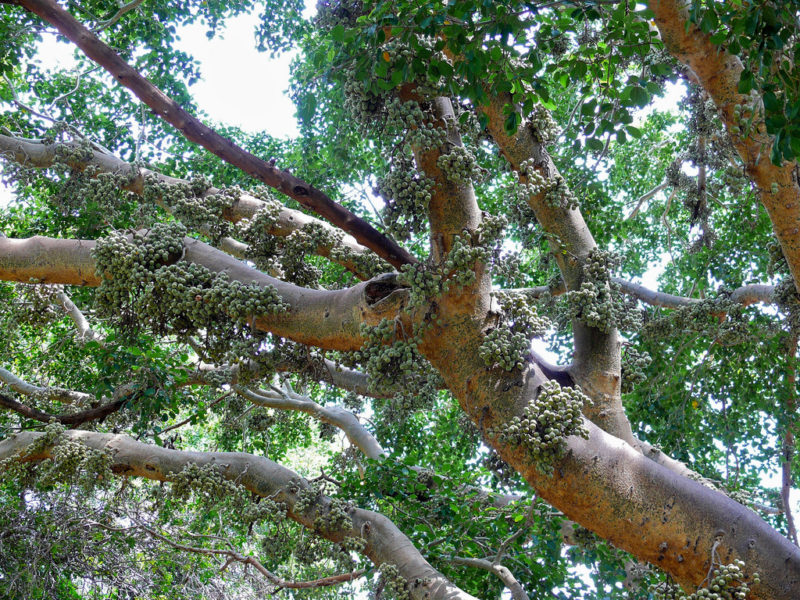Bernard Dupont CC BY-SA 2.0
By Mike Shanahan
On a moonlit night in southern Africa, a reproductive race is about to begin. The stakes are high but so are the risks. Most of the competitors will be dead or doomed by dawn. The starting line is a solitary fig tree whose gnarled form towers over a small stream. Figs hang in clumps from its branches like a plague of green boils. Tonight they erupt with life.
An insect emerges from a hole in one of the figs. She’s so small you could swallow her and not notice. She’s a fig-wasp with an urgent mission and her time is running out. All around her, thousands of her kind are crawling out of figs. Each one is a female with the same quest, and each faces immediate danger. Ants patrol the figs, and they show no mercy. Their huge jaws will crush and dismember any fig-wasp that delays her maiden flight.
Our fig-wasp avoids this fate with a flap of her wings that lifts her clear of the carnage. She carries inside her body a precious cargo, hundreds of fertilised eggs that she can only lay in a fig on another tree. But she is fussy. The fig she seeks must be from the right species of Ficus , and it must be at the right stage of development. If it is ripe, she will be too late. If it is too small, the fig will not let her enter. The nearest fig that fits the bill could be tens of kilometres away.
The wasp does not have time on her side. With every minute that passes her energy stores deplete and can never rise again, for in her short adult life she never once eats. She has less than 48 hours to complete her mission and although she has left the ants behind, the air brings fresh danger.
Out of the dark night swoop bats, their mouths agape, their stomachs empty and expectant. The bats fly looping sorties through the clouds of dispersing wasps, condemning those they swallow to an early death. Our wasp escapes only when a gust of wind blows her high into the sky. She has eluded the predators. Now she must face the elements.
The fig-wasp is less than two millimetres long and her wings are thinner than a human hair. But relative to her body, they act as huge sails. With them, she rides the wild winds in search of a fig. She relinquishes control. Her fate is random now. Some of her cohort will be lucky and find their target within the hour. Many more will drop out of the sky, dead from exhaustion. The wind buffets her this way and that. All the while she awaits a signal from below, for the fig-wasp has allies in the trees she seeks.
The trees need the wasps just as much as the wasps need their figs. Fortunately for both, fig trees are great chemists, and this makes them great communicators. This is now a time to talk about pheromones, which are organic compounds that – when inhaled – induce specific behaviors in animals and humans such as a mating response. These compounds act in concert, like a choir of distinct voices that calls out ‘welcome’ or ‘I’m here’ in a language only certain kinds of creatures can understand. The pheromones the trees make are unique to each species of Ficus, and are made specifically to attract the fig wasp.
And there it is – a whiff of the perfume she seeks. As soon as she recognises it, she seizes control of her destiny and drops down out of the sky. She has found a patch of forest. Somewhere within it is a fig tree whose figs emit the signal scent. Away from the wind, she must now rely on her weak wings to carry her to the odour’s source. The tree’s figs are just right – smaller and harder than the one she departed. The fig-wasp has found her target but she has no time to rest. The final centimetre of her immense journey is among the hardest.
At the tip of the fig is a tiny hole. The fig-wasp squeezes her head into the hole and, with a resolute push from her slender legs, she forces herself forward into darkness. The narrow tunnel in which she finds herself is tight. As she struggles forwards, its walls snap her antennae and wrench the wings from her back. It does not matter. This is a one-way journey and she will not need them again. She has come to give life but also to die, deep in the hollow heart of this special kind of fig.
The fig-wasp has other anatomical adaptations to help her reach her goal. Her head is shaped like a flattened wedge, ideal for forcing her way into the fig. Her jaws bear tooth-like ridges that dig into the tunnel walls. By opening and closing her mouth, the wasp ratchets herself forwards.
At last she reaches the fig’s hollow centre. She can complete her mission. And though the darkness blinds her, she knows exactly what she must do, in these, the last hours of her life. If her genes are to have a chance to survive, she must start to lay eggs, for the cavity at the centre of the fig will be both her tomb and her offspring’s nursery.
Our wasp belongs to a species scientists call Ceratosolen arabicus and her partner is the sycamore fig (Ficus sycomorus). This tree reaches up to 25 metres in height, with a dense crown of leaves that can spread twice as wide to form a canopy the sun’s rays struggle to breach. The sycamore fig grows wild across a great swathe of Africa. Wherever it grows it has become embedded in local cultures, often as a symbol of peace and unity – a place elders go to settle disputes.
It is an ironic choice of icon, for figs are violent places. Within these ‘fruit’ you can find parasites that feed on living flesh and assassins that can only survive by killing babies. Figs are arenas of deadly gladiatorial battles and hasty incestuous sex. As biologist Bill Hamilton noted, in just one day as many as a million insects can die violent deaths inside the figs of a single tree.
Our fig-wasp’s quest to reproduce does not end when she finds a fig where she can lay eggs. She has enemies ahead. She is deep inside the fig now. Flowers line its entire inner surface. They are packed together, their heads forming a carpet on which the wasp walks. As she does, she deposits pollen she has brought with her from the fig of her birth.
Each flower she pollinates can develop into a miniscule fruit with a single seed, an embryonic Ficus sycomorus that has the potential to grow into a giant tree. But not every flower shares this fate. Some of the fig’s flowers will produce a new wasp instead of a seed. This is the price the fig tree pays for such a reliable pollination service.
To take her payment, the mother wasp gets down to the urgent business of laying eggs. One by one she penetrates the fig’s female flowers with a flexible, needle-like structure at the end of her body. Through this hollow tube, she injects an egg into the part of the flower that would normally produce a seed. Each time she lays an egg, she also injects a drop of fluid. This induces the flower to develop a growth called a gall that will enclose and sustain her offspring. The larvae that hatch from her eggs will feed on the plant tissue in their galls until they are ready to metamorphose into adults.
The mother wasp must work fast. Her energy reserves are running low and she has competition. Others of her kind have arrived and they too covet the limited supply of flowers. If she is fast our wasp can lay more than 200 eggs. Finally, exhausted, she dies. Her final act will help ensure the fig species survives. And, because of this, the tiny wasp will affect the fates of thousands of other species, all bound up in an intricate web of interactions that connects plants and fungi, microscopic mites and parasitic worms, birds and bats, monkeys and apes – and even you and me.
Figs feed wildlife than any other plants – including at least 1,270 species of birds and mammals. Without figs and their fig-wasps many of these animals would starve. That’s because most plant species produce their fruit at a specific time of year – often when many other species fruit too. This means fruit-eating animals experience periods of feast and famine as the amount of fruit in an area peaks in just a short period. But if all members of a Ficus species produced their figs at the same time, the short-lived female wasps that emerge from the figs would have no new immature figs in which to lay their eggs. It would mean no more pollination. This would doom both wasp and tree species to extinction.
Instead many Ficus species produce figs all year round, never all at the same time, and individual trees can produce two or more crops each year. Each day, the figs and their wasps introduce new beats to a rolling rhythm of fig production. It is one of nature’s coolest tunes. It offers a lifeline to wild animals and so places Ficus species at the centre of vast ecological webs. The birds and mammals that eat figs will also disperse the seeds of many other plants whose fruit they eat. It is because of this that ecologists have described figs as keystone resources in tropical forests.
A keystone on a bridge or an archway locks all of the other stones into position. Remove it and the structure will come tumbling down. Remove keystone figs from a tropical rainforest, the analogy suggests, and this could trigger a cascade of local extinctions as birds, monkeys and fruit bats starve and are no longer around to disperse the seeds of thousands of other plant species. In 1986, John Terborgh, then a biology professor at Princeton University, suggested that if figs disappeared from Peru’s Amazon basin, the entire ecosystem could collapse.
Later studies have identified a keystone role for figs in other forests, from Panama to South Africa to Malaysia and Indonesia. Biologist Daniel Kissling showed that across all of sub-Saharan Africa, the number of Ficus species in an area was the main factor affecting how many fruit-eating bird species lived there. Kissling concludes that figs are keystone resources on a continent-wide scale.
Right now, as you read these words, fresh dramas are playing out at fig trees across the tropics and subtropics, just as they have done every day for tens of millions of years. At some trees, fig-wasps are emerging from their figs and setting out on their bizarre and fatal journeys. At other trees, fig-wasps are arriving, bearing pollen and eggs. Without these ancient odysseys, the world would be utterly different.
Mike Shanahan is a freelance writer with a doctorate in rainforest ecology. He has written for The Economist, New Scientist, Nature, BBC Earth and Newsweek, and is the author of Ladders To Heaven: How fig trees shaped our history, fed our imaginations and can enrich our future (US title: Gods, Wasps and Stranglers).

